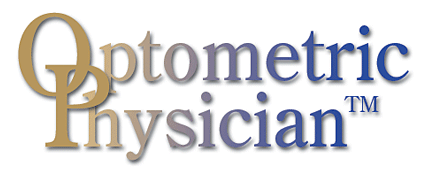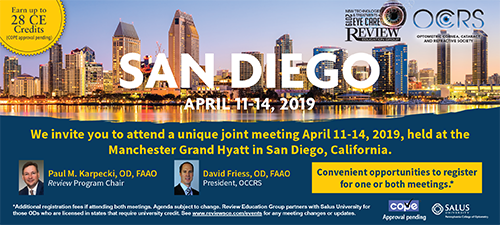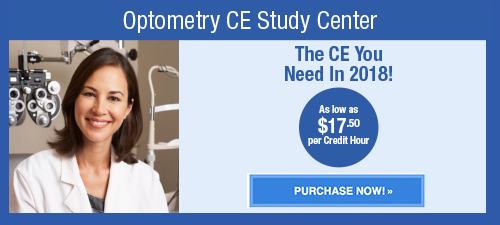
A
weekly e-journal by Art Epstein, OD, FAAO
Off the Cuff: Celebrating Our Mentors
Every Year at SECO, going back just about as far as I can remember, Review of Optometry has hosted an annual dinner on Thursday night. What started out as a small gathering of friends in the back room of Morton’s on Peachtree in Atlanta has grown into a veritable Who’s Who in the profession and industry. While every year has been memorable, some years have been more poignant than others. This year was one of those years. In his gracious acceptance of this well-deserved award, which was one of many, Donald spoke about three immensely important things. He shared the importance of education and how the pursuit and sharing of knowledge empower and drive us forward. A noted observationalist, Donald emphasized the power and importance of observation. This especially resonated with me. Perhaps the most important thing Donald spoke of was the need for collaboration. His world-changing work in contact lenses and anterior eye have been driven by his love of learning and teaching, the power of his keen observational skills, but possible only because of collaboration with others. These are important life lessons we should all learn from. I am happy to announce that beginning next year, Review’s Lifetime Achievement Award is being renamed the Dr. Frank Fontana Lifetime Achievement Award.
|
|||||
 |
||
| Topical Aqueous Suppression and Closure of Idiopathic Full-Thickness Macular Holes | ||||
Researchers wrote that hydration of retinal tissue has been proposed as a potential model of macular hole (MH) formation in addition to tractional forces of the vitreous and internal limiting membrane (ILM). They added that carbonic anhydrase inhibitors have previously been utilized in the treatment of cystoid macular edema in outer retinal diseases, and there has been recent interest in the use of topical aqueous suppression as a potential medical therapy for MHs.
In this case series, four eyes with small (<300μm) full-thickness MHs were treated with topical dorzolamide-timolol for one month. Two eyes achieved closure of the MH without surgical intervention, whereas the other two required pars plana vitrectomy with ILM peel. Researchers concluded that future studies would be required to investigate the role of topical aqueous suppression in the management of MHs. |
||||
SOURCE: Su D, Obeid A, Hsu J. Topical aqueous suppression and closure of idiopathic full-thickness macular holes. Ophthalmic Surg Lasers Imaging Retina. 2019;50(2):e38-e43. |
||||
 |
||
| Fluctuations of the Intraocular Pressure in Medically vs. Surgically Treated Glaucoma Patients by a Contact Lens Sensor | ||||
Intraocular pressure (IOP)-related fluctuations were measured for 24 hours using a contact lens sensor (CLS) to compare fluctuations in IOP in medically versus surgically treated glaucoma patients. Monitoring with CLS in 91 eyes of 77 patients was performed; 59 eyes were receiving ocular hypotensive medication and had no previous history of glaucoma surgery (medical group), while 32 eyes with open-angle glaucoma (OAG) had previously undergone glaucoma surgery (surgical group). The main outcome measures were amplitude, expressed as an indicator of the IOP-related fluctuation; and the presence of a nocturnal acrophase. Investigators also identified maximum and minimum IOP-related values for each patient.
The mean (SD) amplitude of IOP-related CLS signal in the group of surgically treated eyes was 100(41) mV eq, while in the medically treated group, it was 131(69) mV eq. Researchers found that 42.9% of the surgically treated glaucoma group exhibited an absence of nocturnal acrophase, while only 13.8% of the medically treated group. The maximum and minimum IOP-related values for the medical group were statistically higher than the surgical. Investigators found that IOP-related fluctuations were larger in eyes with medically treated glaucoma than in surgically treated glaucoma. A significantly larger fraction of the surgical group exhibited an absence of nocturnal acrophase compared to the medically treated group. |
||||
SOURCE: Muniesa Royo MJ, Campaña JE, Iglesias IB. Fluctuations of the intraocular pressure in medically versus surgically treated glaucoma patients by a contact lens sensor. Am J Ophthalmol. 2019; Feb 13. [Epub ahead of print]. |
||||
| Late Detachment of Descemet's Membrane After Penetrating Keratoplasty For Pellucid Marginal Degeneration | ||||
Researchers reported a case of late spontaneous large detachment of Descemet's membrane in recurrent pellucid marginal degeneration after penetrating keratoplasty. A 73-year-old man presented to a clinic with spontaneous detachment of his Descemet's membrane 30 years after penetrating keratoplasty for pellucid marginal degeneration. Efforts were made to bubble the membrane back into place without success. The patient then underwent endothelial keratoplasty with successful restoration of cornea clarity. Researchers wrote that the condition might cause diagnostic and treatment dilemmas if not properly identified and managed. In addition, they added that their findings has information for both the use of scleral contact lens and the success of endothelial keratoplasty in an extremely steep cornea. |
||||
SOURCE: Lin J, Hassanaly S, Hyde RA, et al. Late detachment of Descemet's membrane after penetrating keratoplasty for pellucid marginal degeneration. Am J Ophthalmol Case Rep. 2018;13:151-153. |
||||
| News & Notes | |||||||||||||||
| B+L Gets FDA Nod for Lotemax SM (Loteprednol Etabonate Ophthalmic Gel) 0.38% Bausch + Lomb announced that the FDA has approved Lotemax SM (loteprednol etabonate ophthalmic gel) 0.38%, a new gel formulation for the treatment of postoperative inflammation and pain following ocular surgery. Lotemax SM uses novel SubMicron (SM) technology to control ocular pain and inflammation after all ocular surgeries. Compared with Lotemax Gel (loteprednol etabonate ophthalmic gel) 0.5%, Lotemax SM delivers a submicron particle size for faster drug dissolution in tears and provides two times greater penetration to the aqueous humor. The company developed SM technology to adhere to the ocular surface and then penetrate key ocular tissues. Submicron particles help improve drug exposure into the aqueous humor. Similar to its gel counterpart, Lotemax SM employs moisturizing ingredients (glycerin and propylene glycol), a pH close to that of human tears and the lowest preservative percentage (0.003% benzalkonium chloride) in a loteprednol etabonate formulation. Read more. |
|||||||||||||||
| COVD & NORA Issue Joint Recommendation for Optometric Evaluation Following Brain Injury The College of Optometrists in Vision Development and the Neuro Optometric Rehabilitation Association issued a joint call-to-action to healthcare professionals to consider the need for medical and/or functional optometric rehabilitation services for patients who have suffered a traumatic brain injury, such as a concussion, or due to a medical condition such as stroke, tumor, aneurism, meningitis, cerebral palsy or other neurological insults. Given the high rate of visual symptoms and known impact, both COVD and NORA urge healthcare professionals to consider the possibility that a patient’s ocular or visual signs or symptoms might have been a result of a brain injury and refer him/her to an optometrist who has special expertise in the assessment and treatment of visual disturbances associated with damage to the central nervous system. Read more. |
|||||||||||||||
| Atlantis Scleral Deep Savings Spare Lens Program In response to practitioner feedback, X-Cel Specialty Contacts updated the Atlantis Spare Lens Program to offers Atlantis lenses in duplicate parameters at a savings of 40% to 50% off the standard price when purchased within 90 days of the patient’s final Rx. This savings gives the eye care professional an affordable option for patients who cannot function without their specialty lenses should one become lost or broken. The company also offers travel-sized, mirrored patient kits that bring convenience and a place to store spare lenses. Learn more. |
|||||||||||||||
| eyeBrain Medical & IDOC Partner IDOC and eyeBrain Medical announced a multiyear partnership to bring breakthrough neurolens prescription lenses to all IDOC members across the U.S. neurolenses are prescription lenses that add a contoured prism to bring the eyes into alignment in order to relieve the headaches, neck/shoulder pain and eyestrain that many people experience when using digital devices, reading or doing detail work. Learn more. |
|||||||||||||||
|
|||||||||||||||
|
|||||||||||||||
|
Optometric Physician™ (OP) newsletter is owned and published by Dr. Arthur Epstein. It is distributed by the Review Group, a Division of Jobson Medical Information LLC (JMI), 11 Campus Boulevard, Newtown Square, PA 19073. HOW TO ADVERTISE |




